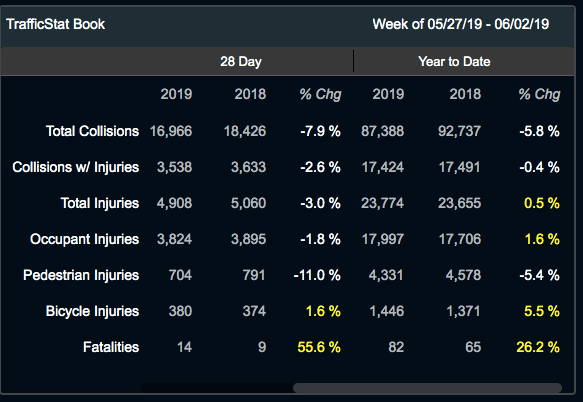Road Fatalities Are Way Up* (Yes, That’s an Asterisk)

To paraphrase “The Wizard of Oz,” pay no attention to those statistics on that seemingly official NYPD website — traffic fatalities are not up 26.2 percent through June 2 this year. They’re “only” up 22.4 percent.
This hardly good news comes from the Department of Transportation, which has been encouraging media outlets to use its reconciled crash numbers instead of the NYPD’s official, but preliminary, TrafficStat numbers, which are posted on the NYPD website every Wednesday.
Streetsblog is officially adopting this policy. But either way you cut it, it’s been a terrible year in Vision Zerotown.
According to both the DOT and NYPD’s numbers, 82 people were killed on the streets of New York between Jan. 1 and June 2 this year. That’s an increase of 22.4 percent, according to the DOT, or an increase of 26.2 percent, according to the NYPD, over the same period last year.
About that discrepancy: The DOT says its data reflect subsequent review of the circumstances of all crashes. As a result, the DOT sifts out fatalities that occurred on private property or were, say, the result of a medical episode such as a heart attack that killed the driver. The ruling from the medical examiner’s office often comes months after a crash, and those determinations aren’t factored into the NYPD numbers, according to DOT.
Deaths on non-public roadways or the result of a medical episode are not included in the agency’s data on road deaths. And the NYPD numbers can sometimes appear to be lower in a given period because preliminary police data does not factor in fatalities that occur months after the crash itself.
So that’s why the DOT says there were 67 fatalities over the same period last year versus the 65 in the NYPD report. Neither agency gave details about the two additional fatalities that the DOT says occurred between January and June last year, but the DOT’s higher figure from last year is a result of the agency’s reconciliation. (Indeed, the DOT says its latest numbers posted today — January 1 through June 4 of this year — show a drop in total fatalities to 81. That reduction of one fatality is not likely be in next week’s NYPD statistics. Using that number, fatalities are up 20.8 percent this year.)
“Especially early in a year, [NYPD] TrafficStat may therefore over-estimate current-year fatalities while under-estimating previous year totals,” a DOT spokesman said.
So that’s good…er, bad. Even using the DOT’s reconciled numbers, 2019 has been a bloody year on New York City streets.
According to the agency, the 82 fatalities through June 2 include 46 pedestrians (which is eight more than over the same period last year), 10 cyclists (which matches the deaths for all of last year), six motorcyclists, and 20 motor vehicle occupants, up from 14 last year.
So here’s what that looks like statistically:
- Total deaths, up 22.4 percent.
- Pedestrian deaths, up 21 percent.
- Cyclist deaths, up 66.6 percent.
- Driver deaths, up 25 percent.
Like Streetsblog, activists have begun to accept the DOT counts, but point out that they offer little consolation.
“Quibbling over tiny discrepancies in data isn’t going to make anyone safer,” said Doug Gordon, who tweets as BrooklynSpoke. “If I’m killed by a driver, it won’t make a whit of difference to my wife and kids if I’m the 68th or 66th pedestrian or cyclist fatality this year so far. All they’ll care about is that I’m dead. DOT has all the tools it needs to make sure no lives are lost to preventable crashes; what it lacks is the proper leadership and political will to prioritize people over parking.”
And Marco Conner of Transportation Alternatives added this:
We can conclude by DOT’s own account that the 2019 fatalities are likely higher than they can determine right now, and hence that their 2019 year-to-date numbers will increase retroactively when they reconcile medical data, including for people who die weeks or months after sustaining their traffic related injuries. Historically, DOT’s own reported fatality numbers increase retroactively — we saw this at least as recently as 2017. NYPD’s numbers are likely closer to adjusted year-end numbers.
But the fact remains that people are dying. Whether the calculation is made one way or the other is entirely irrelevant and is infuriating. Whether it’s 100 or 200 people dying — either is unacceptable as a City with tremendous resources. We can do so much better than the current piecemeal approach to Vision Zero by Mayor de Blasio. The refusal by the mayor to take head-on our harmful car-culture is the reason why we are not making progress at the accelerated pace that we need to prevent serious injuries and the loss of life. This is not about DOT, it is about the mayor who needs to stop blocking the bike lane and give Commissioner Trottenberg and her team free reins to make every street in the New York City as safe as it can be.
